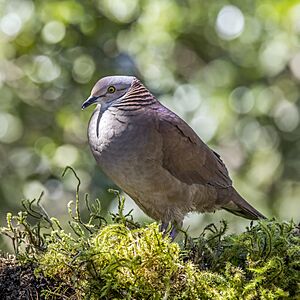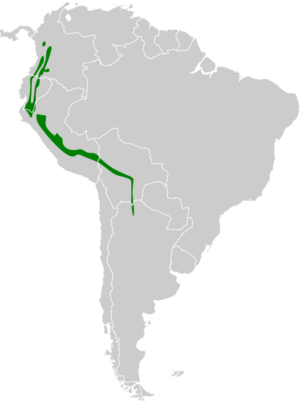White-throated quail-dove facts for kids
Quick facts for kids White-throated quail-dove |
|
|---|---|
 |
|
| Zentrygon frenata bourcieri, Colombia | |
| Conservation status | |
| Scientific classification | |
| Genus: |
Zentrygon
|
| Species: |
frenata
|
 |
|
| Synonyms | |
|
|
The white-throated quail-dove (Zentrygon frenata) is a type of bird that belongs to the Columbidae family, which includes doves and pigeons. You can find this bird in several South American countries, including Argentina, Bolivia, Colombia, Ecuador, and Peru.
Contents
How Scientists Name This Bird
Scientists who study animals, called biologists, give every living thing a special name. This helps everyone know exactly which animal they are talking about. The white-throated quail-dove's name has changed a few times over the years. It was first called Geotrygon and then Oreopeleia bourcieri before getting its current scientific name, Zentrygon frenata.
There are four main types, or subspecies, of the white-throated quail-dove. These are:
- Zentrygon frenata frenata
- Zentrygon frenata bourcieri
- Zentrygon frenata subgrisea
- Zentrygon frenata margaritae
Sometimes, people thought one of these, Z. f. bourcieri, was a completely different species. But now, scientists agree that all four are just different versions of the same bird.
What Does It Look Like?
The white-throated quail-dove is a fairly large bird, measuring about 30 to 34 centimeters (12 to 13 inches) long. That's roughly the size of a large pigeon! It weighs around 311 grams (11 ounces).
Male birds have a buff (light yellowish-brown) color on their forehead and lower face. Their head is a blue-gray color. The top part of their back is a deep purple, and the rest of their upper body is reddish-brown. Their throat is white, their chest is gray, and their belly and sides are a dark buff color.
Female birds are a bit browner than the males. Young birds look similar to the females but have dark stripes on both their upper and lower bodies. The different subspecies have slight differences in the colors of their heads.
Where Does It Live?
The white-throated quail-dove lives in the Andes mountains in South America. Each of the four subspecies lives in a specific area:
- Zentrygon frenata bourcieri lives in western Colombia and parts of Ecuador.
- Zentrygon frenata subgrisea is found in southwestern Ecuador and northwestern Peru.
- Zentrygon frenata frenata lives from northern Peru down to central Bolivia.
- Zentrygon frenata margaritae can be found in southern Bolivia and the very northwestern part of Argentina.
These birds prefer to live in humid, green montane forests. They usually live at high elevations, between 900 and 3,000 meters (about 3,000 to 9,800 feet) above sea level. Sometimes, they might be found a bit lower, around 700 meters (2,300 feet).
How It Behaves
Feeding Habits
The white-throated quail-dove looks for its food on the ground. It usually searches alone, but sometimes you might see one or two other birds foraging nearby. Scientists haven't fully documented what this bird eats, so its diet is still a bit of a mystery!
Reproduction and Life Cycle
The time of year when white-throated quail-doves have their babies seems to change depending on where they live. One nest that was found was a flat platform made of twigs and leaves. It was placed about 2 meters (6.5 feet) above the ground in a tangled group of plants. This nest held one egg. We don't know much else about how they raise their young.
What Does It Sound Like?
The song of the white-throated quail-dove is a single, low-pitched sound that goes "whoOOo." The middle part of the sound is the loudest.
Its Conservation Status
The IUCN (International Union for Conservation of Nature) has evaluated the white-throated quail-dove and listed it as a species of "Least Concern." This means that, for now, scientists believe its population is stable and it is not in danger of disappearing. However, its exact population size hasn't been measured. Not much is known about its life and where it lives, and it seems to be found in scattered areas rather than everywhere.


